Interview: Aston Microphones’ James Young and Jack Munro on its new Stealth model
With the release of its new Stealth – described as “the world’s most flexible microphone” – Aston is taking on the big boys. In this Industry Gurus special, MusicTech catches up with the
only British company to manufacture microphones to get the lowdown on this most audacious of new-product launches…
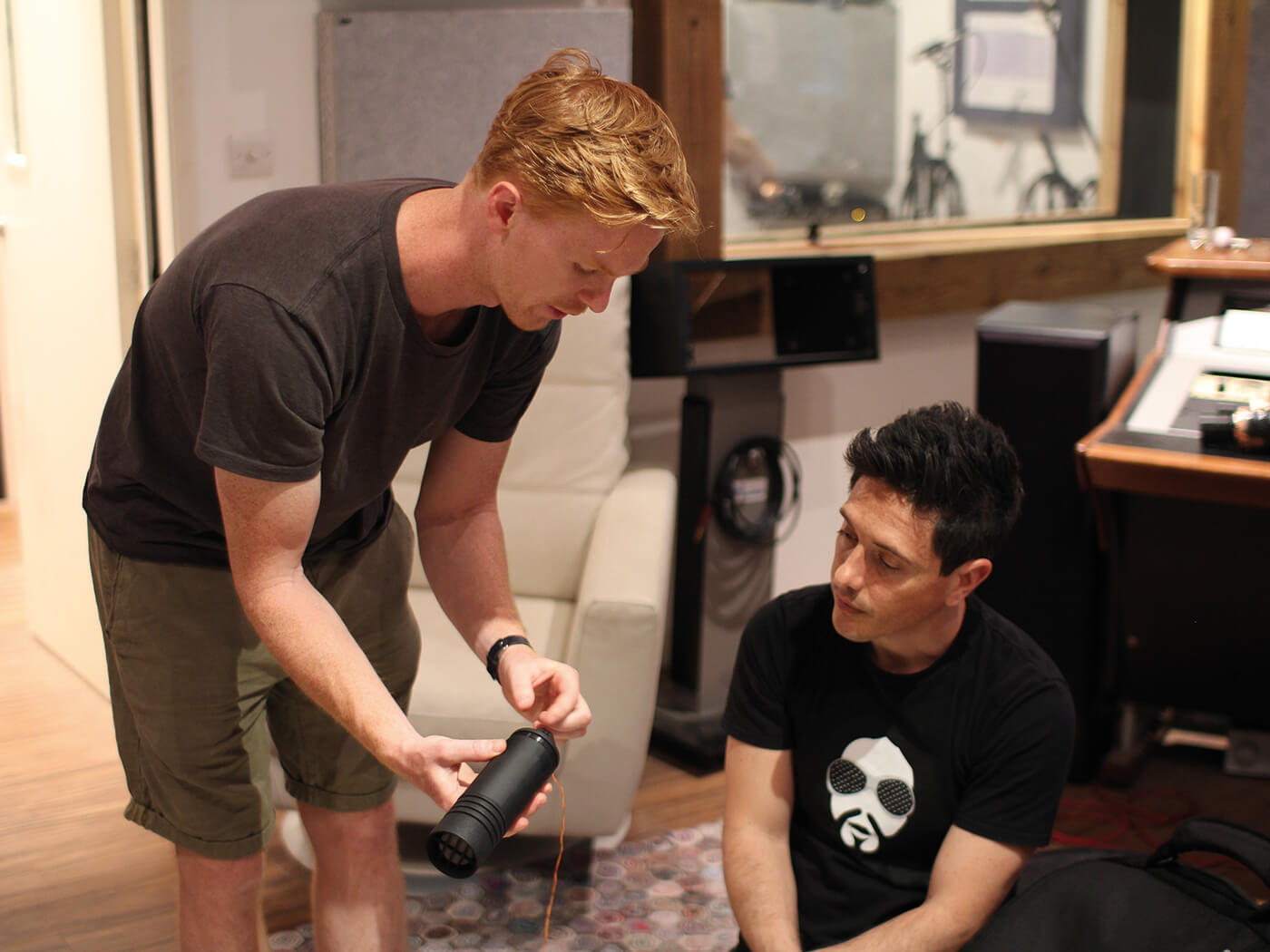
Aston’s Jack Munro (left) with ex-Stereophonics drummer and solo artist Javier Weyler
We get excited by gear here at MusicTech – probably a little bit too much. The idea of a studio festooned with the latest synths, software, outboard and controllers is something that fills us with delight, to the point that we write features about them month after month.
But microphones? Don’t get us wrong, we do appreciate the attraction of a classic Neumann, the appeal of an AKG, the special charm of a Schoeps and the industry standard that is the Shure SM.
However, let’s face it, microphones are not exactly breaking down barriers, as the technology behind them is largely the same as it was decades ago. So when a company such as Aston – a UK one at that – comes along and shakes things up a bit; well, maybe microphones can be as sexy as synths after all…
Aston has already caused a bit of a stir in the space of just three years. Origin, its large-diaphragm single-pattern condenser, was the company’s first release and that mic garnered a 10/10 in MusicTech back in 2015, with Mike Hillier stating that it was a “refreshing twist and a superb-sounding microphone for a variety of tasks”.
That was quickly followed by the multi-pattern all-rounder Spirit mic, and another MusicTech Award, with Hillier saying: “The Spirit is virtually a must-have – it performs well enough to add to any mic locker, and is also inexpensive enough to demand your attention.”
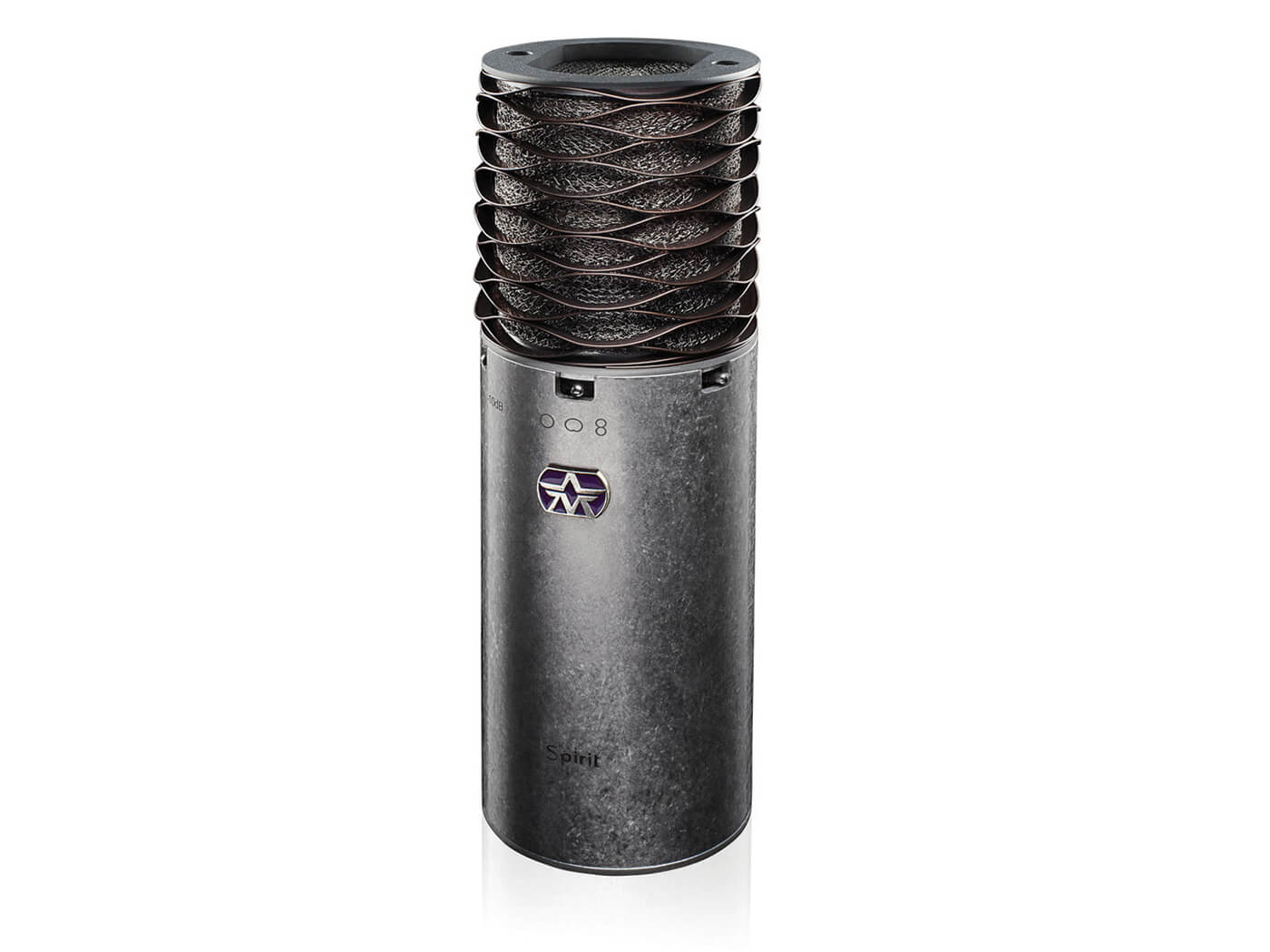
Where these two scored on the ‘difference’ stakes was with robust finishes and unique designs, but the Starlight cardioid condenser grabbed even more attention with its laser-guided accuracy. “Every studio needs a pair of small-diaphragm condensers,” said Hillier, “and by offering three voicings in the Starlight, Aston is making a solid case to be the first mic you reach for when you do.”
With pop shields and the Halo reflection filter gaining similar praise, now it’s the time for a brand-new microphone, Stealth – but this one comes with even bigger ambitions. The new model is described as “the world’s most versatile microphone”, no less, and is the first with an autodetect function to sense 48V phantom power while also featuring a built-in Class A mic preamp. Add a ‘unique Sorbothane’ internal shock-mount system and it’s a triple whammy of design firsts.
We sat down with Aston MD James Young and designer Jack Munro – son of the legendary acoustic designer Andy Munro – who told us more, in this exclusive chat, direct from Aston’s UK HQ.
Aston starting
Tell us about the original Aston brief. What did you set out to do with your microphone designs?
James Young: The brief was first that we wanted to manufacture our mics in the UK and second, that we wanted to build within a certain price point, because there is always a danger that if it’s at a high price point, people might say: ‘It’s only expensive because it’s made in the UK.’ So to have a combination of UK manufacturing and a price point that competes with RØDEs, low-end AKGs and the like is compelling. The third part of the brief was that the microphones would have to be innovative, because there is just way too much stuff out there that is just off-the-shelf ‘us too’ product. There is a lot of the ‘we’ll just do another version of that or that’, and we definitely didn’t want to do stuff out of China for that reason as well.
So the mics needed to look different, but not in a ‘let’s make it look whacky’ kind of way. We wanted to make something we could produce in a different way to make it cost effective enough to do it in the UK, but in order to do that we had to completely rethink how mics were designed.
Jack Munro: Yeah, the brief was that there are a lot of mics competing for a similar space, so our microphones would have to be something completely different. They would have a function, be completely practical, but look completely different to anything else and stand out against the crowd.
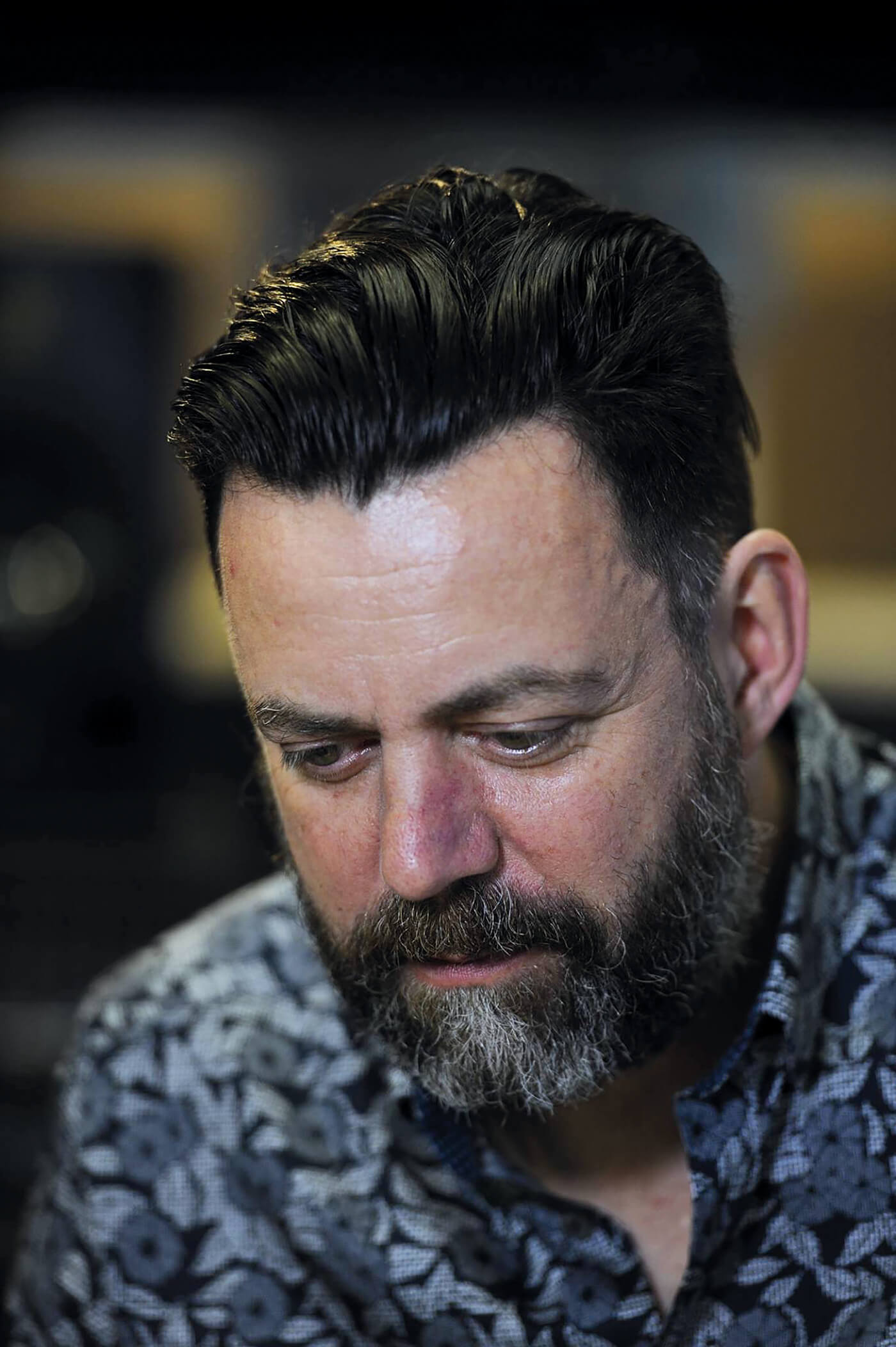
That’s a huge task in what could be described as a saturated market. Tell us a little bit about that initial development process…
JY: We looked at hundreds of different microphones from nearly a hundred different brands. The initial reason for doing that was to find stuff that people were doing that was interesting, or was good or unique. But instead, what we found was homogeny, that everything was exactly the same. For example, they’ve all got kind of the same basic design for a mesh head.
I mean, there are reasons you have to have a mesh head – you have to have a Faraday cage and it has to be metal and there is also an element that it acts as a pop shield and as protection – but why are they all so similar? And the only reason we came up with is that people must be going: ‘Well, that must be how you make a mesh head, so we’ll copy that.’ But nobody seems to have stood back and said: ‘Well, why does it have to be that way? Why can’t we find some different materials to do it in?’
And so we asked those questions of Jack, and I remember the meeting where he came in with this waveform spring idea – where we could manufacture a mesh head using low-cost waveform springs that are manufactured in their millions. He pulled the idea out and we all said: ‘Fucking hell, that’s brilliant!’ That was the decision about the head made, before we even tested it, and fortunately, it worked!
What else made the microphone designs unique?
JM: Well, every other microphone has a band of framing over the top. It’s partly a structural thing, so you can’t poke your finger through it, but it’s also because you can’t make a completely uniform mesh cylinder – you need this band which connects it.
But as we were using the wave spring design, there was no way to hide the welds anywhere, so we had to try and make a completely seamless cylinder of mesh, which is very difficult. But after a big research phase, we found this method where they take what are like stainless-steel hairs and almost knit it like a fabric into a continuous sock shape. It has no seams, and has loads of layers to it, so works well as a pop shield, too.
JY: So if you buy an Origin, you don’t need a pop shield like you do with other microphones. It’s also hard to damage it because of our design and, oh by the way, it sounds 10 times better, too!
BRAND POWER
The Shure SM57 or 58 must surely be the microphone that every other mic manufacturer wants a slice of, as they sell gazillions. Is that market also a target for Aston Microphones?
JY: Every man and his dog wants to take a bit of the SM58 market, because Shure rules that market. And they don’t rule that market because it’s the best microphone; it just does what it does and that’s what people want. For example, it doesn’t have quite enough top, so engineers then haven’t got to control the feedback. So lots of people have done a better mic, but at the end of the day, the marketing and the brand is so strong that a punter who knows nothing at all about mics will go into a store and go: ‘I want an SM58.’ So if we go in that area, it will be as an accessory, not a core product.
A new stealth mission
So what can you tell us about the new Stealth microphone?
JY: The aim was not any different from the rest of the projects, really. It was that it’s
got to be made in the UK, it’s got to be innovative, no ‘us too’ stuff, and it has to appeal to a group or audience after a specific type of microphone. So we were after the SM7B audience, as no one else is really in there – you have Shure, obviously, you have the RØDE Procaster and that’s it – so the idea was to do a universal dynamic mic.
With your other mic models, you ran blind listening tests. Did that happen with Stealth, too?
JY: Yes it did, and it’s the way we go about sound testing. It’s the way that we work, which is very different to all other companies. Basically, with all of our design work, we don’t make any presumptions about where it is we are trying to get to, and therefore aren’t limited by the perceived wisdom of getting there.
We throw a lot of stuff into the mix where people will say: ‘You can’t do it like that,’
or the perceived wisdom is it won’t work or it will sound poor. We’ve had that multiple times and have debunked it all. The conventional way of testing microphones is by using scientific equipment – put the microphone in an anechoic chamber, put signals through a speaker into it and measure what comes out. If that was infallible, then all microphones would sound the same, but they don’t. You’re testing something objectively to which people have a subjective response, so to me, it’s a non-starter. The only way to test something is to test it with subjective responses, as we do.
So that’s why our main difference is that we do these blind listening tests. We take a bunch of different capsules, record a bunch of different instruments on them and send blind listening tests out to all the audiophiles that we know. Then people vote on it and we progress the mics through different stages of development with different voicings or changes on the PCB.
What matters is that we have put it to the panel and they have told us what they think without knowing what it is they are listening to. We get a seemingly chaotic jumble of results as they come in piece by piece, but when you put it all together, the summary picture makes it absolutely clear what people have voted for.
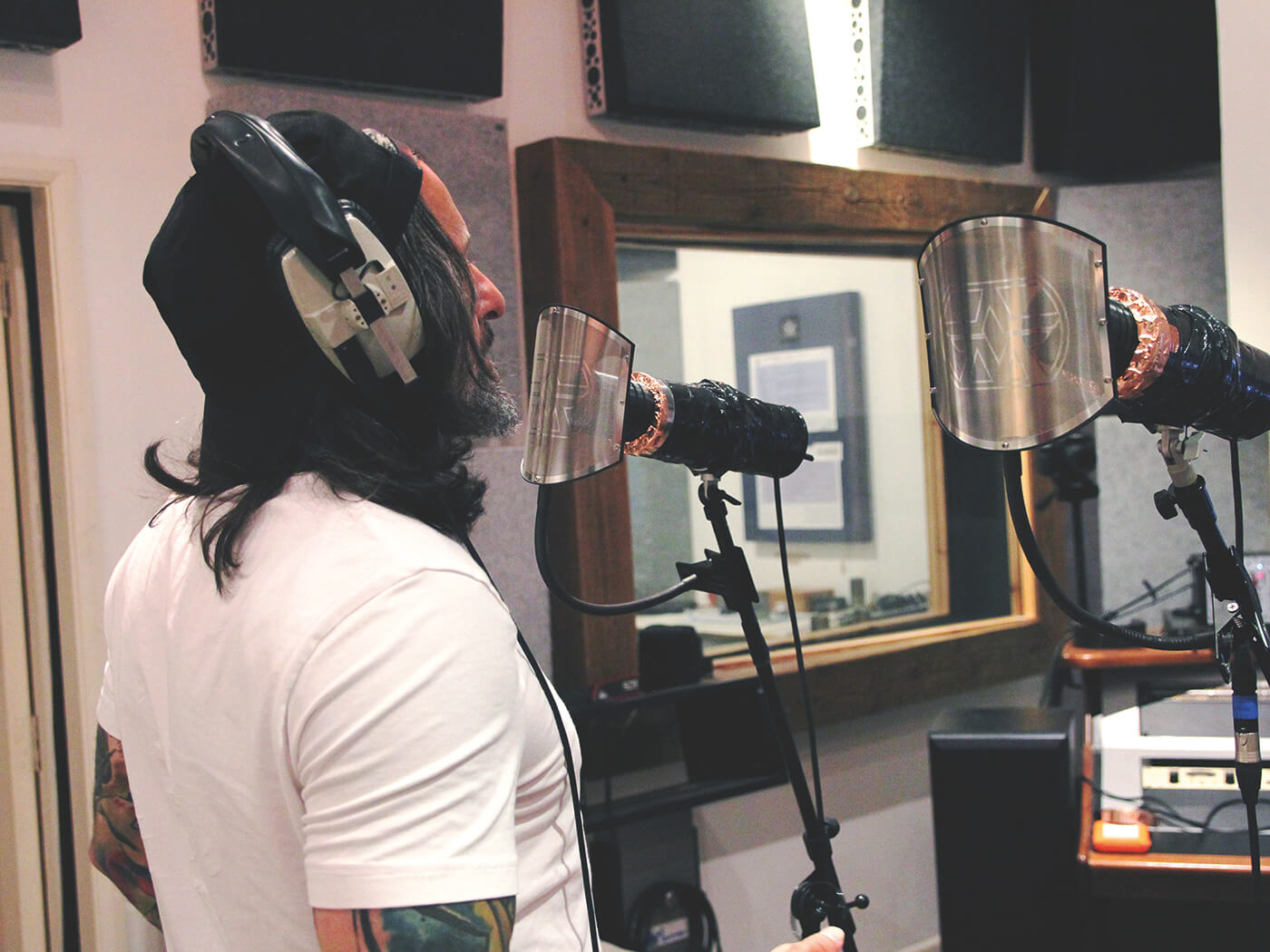
Why don’t other companies follow that kind of approach? It seems an obvious one, after all?
JY: They’ll have a sales team, a marketing team and an engineering team who fight it out. The sales team want everything for a quid, the marketing team want something no one’s ever done – or to market something that is the best thing in the world ever – and the engineering team want to build a space rocket and they don’t give a shit how much it costs!
Those three conflicting opinions end up getting watered down so much that you end up with something that is exactly the same as the last thing, maybe with a new paint job on it. There seem to have been very few brave decisions from our industry, so you end up with this mushy, boring nothingness and I think we’ve been very fortunate to hit the market where there has been decades of that behaviour and so we’ve come out of it with something fresh.
So what is different about Stealth?
JY: With Stealth, we wanted to keep the same environmental credentials as we used with our other mics, so it has no nasty paint processes. However, we couldn’t use the same stainless steel and tumbling, as it had to be a black microphone. There are also three things about the mechanical construction that have never been done before. The first is the headstock, the design we talked about earlier.
Theoretically, it should not be a good mic, but it sounds fantastic and looks fantastic, so who cares if the theory is right or wrong? It’s also the world’s first microphone with a full air suspension in it, so it’s actually got a set of compressed air balls that are sat between the chassis and the innards of the microphone. That’s pretty cool, as you don’t need an external shock mount – it’s air suspension, which you get in Rolls Royces and Land Rovers!
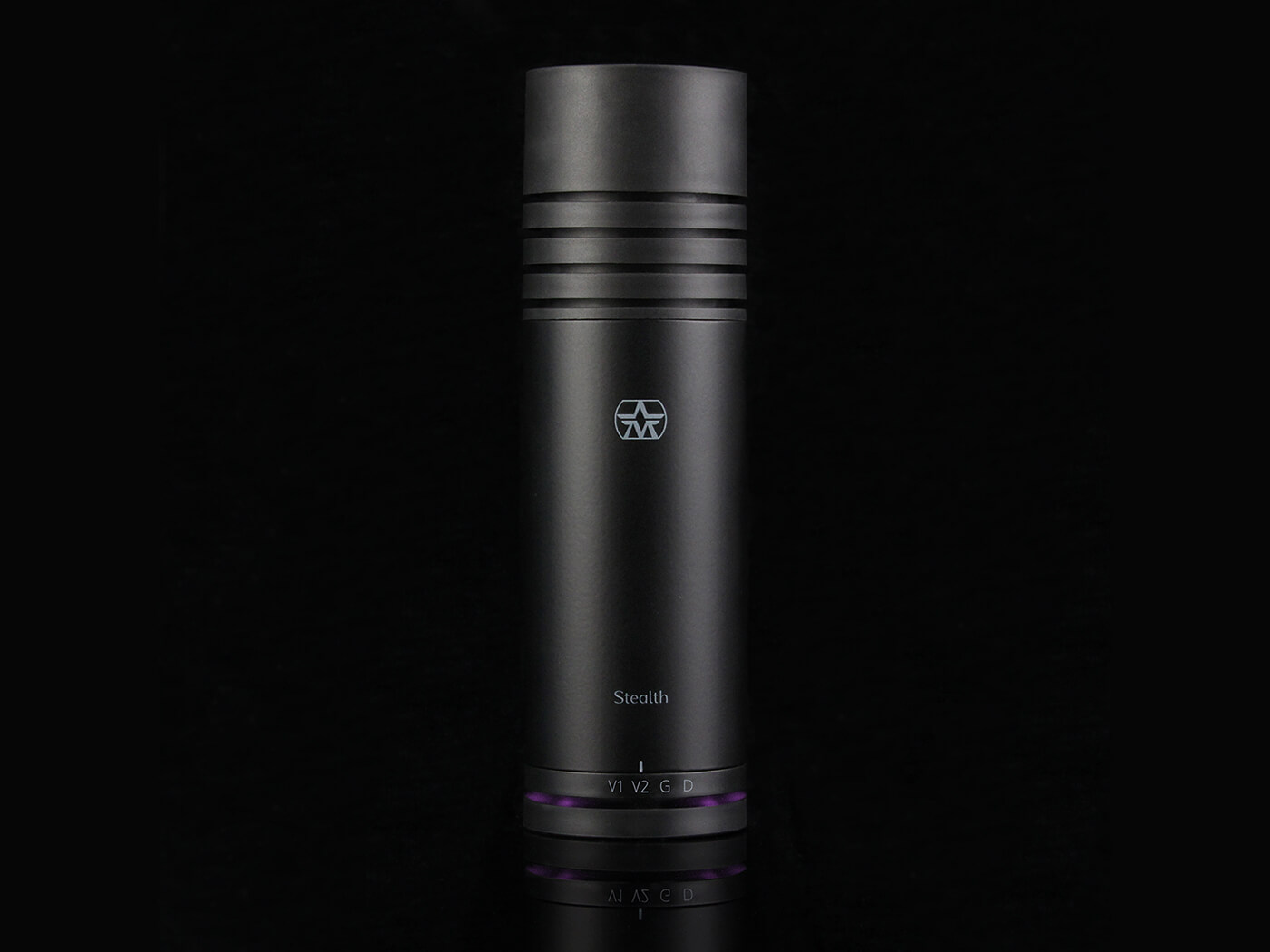
Finally, it’s the first-ever mic – at least we think it is, as we’ve done a lot of looking and can’t find anything – that has active detection of phantom power. So it will work as a dynamic and if you plug it into something that is fed phantom power, it will power up a mic pre, which is a much nicer equivalent of one. That’s £150 worth of kit that you have to stick an SM7B with in order to get any loudness out of it. We’ve built that into the microphone, so if you’ve got phantom power it will just kick in, and we’re only talking £300 for ours!
It also has four voices on it. When we panel tested it against a Neumann U 87 and the Shure SM7B, the SM7B came bottom in every single test and Stealth beat the U 87 in six out of seven tests; that’s how good it is.
TESTING, TESTING
So tell us a little more about those blind listening tests. What sound sources do you use?
JY: We used a dulcimer, trumpet, violin, kick, snare, shakers, female vocals, male vocals, Spanish guitar, electric guitar and steel-string guitar. We have three male vocalists and two female. And it came out pretty clear. We smashed it, across the board. In each case, a person has to rank 14 tracks of each sound – it’s a lot of work!
I then put that together for 90-odd people on our panel and then compile it into a summary sheet. So we had the Stealth microphones, each with four voicings, and a couple of ringers in there, the SM7B and the U 87. Green wins, light green means second, light orange is second last and orange means last. SM7B came last on everything bar one and U 87 didn’t win or lose anything – and Stealth wiped the floor with everything, even over four voicings.
So the final microphone we have put out has the voicings that we can recommend for each instrument. All of our products have something to shout about that is actually different. I guess the big question people will have is that we say that we’ve made them in the UK, they are affordable and sound better than a Neumann, how can that be? That can’t be true. But the reason that it is true, is because of the Aston 33 panel listening tests, simple as that!
You want it all? You can…
It seems that you’re trying to keep your products around the £300 point, whereas other manufacturers can and do charge way more. Tell us about the thinking behind your pricing policy…
JY: Microphones are instruments, right? Producers and engineers use them as a sound palette. So there’s no such thing as ‘that’s the one I’m going to use for a specific task’, unless you’re a vocalist and you just happen to find a mic that suits you. It’s like when a guitarist might use multiple instruments and amps, so you’ll use a different mic for different occasions. As an engineer, you will always want a suite of tools to choose from, so you can pick something out and get the right thing for that sound in that moment.
But if you’re doing that with mics that cost three grand a pop, you need to have some very deep pockets. So if you come across a mic brand that is suddenly offering the same kind of tonal quality and performance as those mics which cost £3,000 – and it’s a range of mics that all sound very different, but only cost £300 each – then as a major producer, artist or engineer, you’re going to say: ‘I’ll have two of those, one of those, three of those!’.
And suddenly, they have this great big suite of tools that they can use that costs them the same as one Neumann! At the same time, all the little guys out there are saying: ‘These guys are using this and it only costs £300 and I can afford that.’ So the biggest issue we have is that people assume, when they see these high-end guys using our products, that they can’t afford them, when they can!
So has that policy paid off? Have you got the big names on board?
JY: “I have a folder in my inbox which I started about a year after we started this company, as I suddenly started realising we’re getting, not fanmail as such, but emails of gratitude from people. I spent 12 years in the industry doing sE and getting on for a decade before that in other companies, and we’ve never experienced having this influx of people saying that we have changed their lives, changed the way they record their music, and thanking us. We get it all the time and it is frankly fucking brilliant.
If you start looking at the artist rosters of other brands, many don’t have that-big names. If you look at Neumann, they don’t need it, because everyone uses them, but all the other brands are scrabbling around and trying to get into the live market so they can get pictures of artists singing with their mics on stage.
But not us, people are coming to us. We’ve had Noel Gallagher, Stevie Wonder, Richard Ashcroft and Queens Of The Stone Age. The list goes on: Muse, Radiohead, Kylie – everyone from classical to pop, Coldplay to Anthrax!